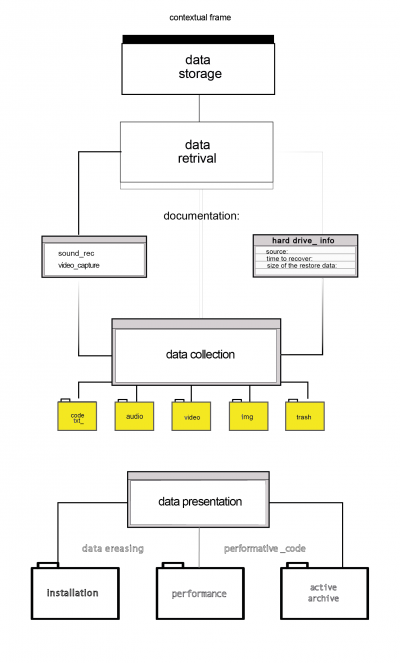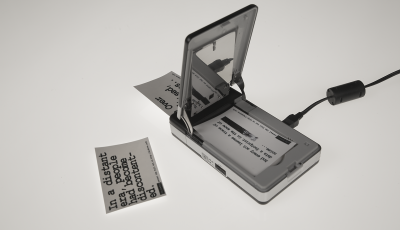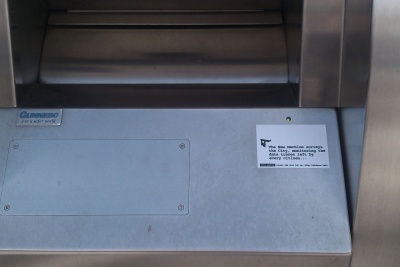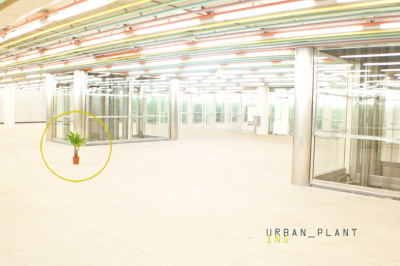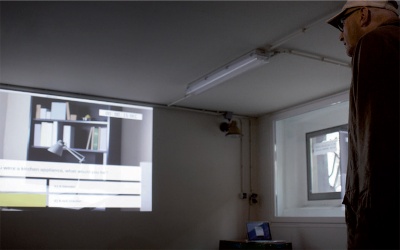User:User:Michaela/proposal/final: Difference between revisions
No edit summary |
|||
| (3 intermediate revisions by 2 users not shown) | |||
| Line 35: | Line 35: | ||
width:700px"> | width:700px"> | ||
I have started a process of retrieving old hard drives disks (data storage) restoring the data out of them, in order to examine abandoned data and leftover traces. By doing this I am exploring the problematic aspect of data erasure.<br> | I have started a process of retrieving old hard drives disks (data storage) restoring the data out of them, in order to examine abandoned data and leftover traces. By doing this I am exploring the problematic aspect of data erasure.<br> | ||
The hard drive rather obsolete object | The hard drive, in this case a rather obsolete object, serves as an ultimate storage of data, container of past and present, which could be also invaded and investigated further.<br> | ||
The traces of information are exponential they contain various sources...they travel, scattered being trade -transacted or serve as a found footage for artistic intervention. | The traces of information are exponential they contain various sources...they travel, scattered being trade -transacted or serve as a found footage for artistic intervention. | ||
This project is trigger by the idea of how the data trace is permanent, could not be destroyed or erased completely. It has been encapsulated within the time, the code and the medium itself. <br> | This project is trigger by the idea of how the data trace is permanent, could not be destroyed or erased completely. It has been encapsulated within the time, the code and the medium itself. <br> | ||
| Line 108: | Line 108: | ||
<br> | <br> | ||
'''Audience:'''<br> | '''Audience:'''<br> | ||
All the projects took place in public space and they tried to involve active participation/ response from the audience. This allows the audience to reflect and affect the final outcome, by providing immediate feedback and it opens possibilities for a dialogue in the physical space.<br> | |||
''' Staging a situation'''<br> | ''' Staging a situation'''<br> | ||
The described works above I tried to provoke reaction and arise some attention. By analyzing the form, scale and the media/ medium, which were used I would like to make the work more visible. | The described works above I tried to provoke reaction and arise some attention to a critical issue. By analyzing the form, scale and the media/ medium, which were used I would like to make the work more visible. | ||
</div> | </div> | ||
| Line 141: | Line 141: | ||
===in larger context:=== | ===in larger context:=== | ||
*[http://www.minimovies.org/documentaires/view/ilovealaska I love Alaska] by Sander Plug and Lernert Engelberts <br> | *[http://www.minimovies.org/documentaires/view/ilovealaska I love Alaska] by Sander Plug and Lernert Engelberts <br> | ||
A series of films based on | A series of films based on the accidental leak of a huge amount of personal queries of AOL users. | ||
I love Alaska narrates the life of user # base on list of her personal search queries, read aloud by a voice-over. | I love Alaska narrates the life of user # base on list of her personal search queries, read aloud by a voice-over. | ||
Over a period of three months, a portrait of a middle-aged woman emerges who is diligently searching for like minded souls... | Over a period of three months, a portrait of a middle-aged woman emerges who is diligently searching for like minded souls... | ||
Latest revision as of 19:56, 2 December 2013
Tentative Title
working title:
[Err ]
Introduction
Etymologically the word ërase” depicts from c.1600, from Latin erasus, past participle of eradere "scrape out, scrape off, shave," from ex- "out" (see ex-) + radere "to scrape" (see raze).
- remove all traces of; destroy or obliterate:
- remove recorded material from (a magnetic tape or medium); delete (data) from a computer’s memory.
During my research I will approach the theme of data traces not looking only at its technological aspect but also using them as the subject of my current work. The inevitable generation of traces and its problematic resistance to deletion will be used as the main motive of a constructed poetic narrative that will take place in a form of an installation in the exhibition space.
How do we leave a trace of an online presence?
The amount of traces/ digital traces in form of caches, cookies, footprint of the browser is
stored, tracked and dumped in the system.
Various tools – PGP (encrypting your email), browser plug- ins, private networks (VPN) – are used to prevent our location to be tracked, our data to be exposed. All of which limits the traces we leave but it doesn't completely erase them. Driven by my personal motivation to explore the limitations of technology and different methods of resistance I became sceptic about the possibility of being able to not leave traces or in other words the (im)possibility to erase the digital footprint.
The common methods to erase files from systems do not delete them permanently. Those files remain hidden, abandoned in hard drives. The traces left remain present within time in the medium, allowing to be retrieved and becoming a subject of study. This fact raises questions about our level of awareness concerning the privacy in the digital realm. The ethical issue I want to address is: who has the right to withdrawal someone's data and how this data could be used, reused or misused? In my work I would like to arise questions concerning problematic aspect of these traces.
Description
I have started a process of retrieving old hard drives disks (data storage) restoring the data out of them, in order to examine abandoned data and leftover traces. By doing this I am exploring the problematic aspect of data erasure.
The hard drive, in this case a rather obsolete object, serves as an ultimate storage of data, container of past and present, which could be also invaded and investigated further.
The traces of information are exponential they contain various sources...they travel, scattered being trade -transacted or serve as a found footage for artistic intervention.
This project is trigger by the idea of how the data trace is permanent, could not be destroyed or erased completely. It has been encapsulated within the time, the code and the medium itself.
How the act of disclosure is already a critic?
Practical steps / Methodology
Due to my background in visual arts and stage design, the notion of space and the text, are relevant elements in my practice that will reflect in this project.
In my research, I am working on a series of projects related to the topic of these found traces, which will end up leading to the final graduation project. I would like to incorporate a poetic aspect of the retrieve data and the idea of the erasure as the main motive in the final work.
I built a simple methodology of data recovery. The data storage is the approached collection of ten hard drives followed by information about the hard drive: the source of origin()
The documentation or the process of recovery consists of video capture of the used software and sound from a spinning hard drive disk (unable to boot). In order to organize this accidentally found archive I simply described the size/ model of each hard drive, the process of the remain time and amount of the restored data.
Data collection consists of rich content of personal data: img files, videos files, audio files, code or text logs and trash (or unrecoverable files or parasite files etc.)
Sample of found material:
- The factory set is a 23 min long video documentation of factory for pineapples in Ghana.
The camera follows the production line of workers assembling pineapples, scene by scene revealing every detail of the process.
The moving images are rich by their source of origin, drawing highly graphical, dense scene of workers in factory motionless in their every day basics.
The images serve as a data trails, conveying the trace of the failure of the recovery process, signed for being "broken" or interrupted. Sometimes the freeze of the frame creates conscious break from the meditation, but also suggest that the footage has been manipulated.
--> screenshots of the footage HERE
methodology and process of recovery could be seen in the worklog--> HERE
key words/ domain of interests:
erase traces, recovery - erase online - offline media, performative code, meta data, plagiarism, "derive"
Relation to previous practice
Description of previous projects:
At the beginning of the academic year I tried to look at traces in poetic order.
In “Urban poetry” I extracted and formulated a visual poem ( a web page and printed stickers), inspired by Faceless project voice over project by Manu Luksch & Mukul Patel. I recombined text and visuals, which evoke the notions of 'traces of data', 'New Machine', 'Current time' and 'Perfect present'. The language of the whole text assembles a play, with a loose narrative. I placed the stickers around the city, inviting the viewers to visit the website in order to reveal the full poem.
- "Urban planting" is a situation specific small intervention in public space.
I took a plant, a common interior feature, and placed it out of its context at the Rotterdam Centraal metro station. I intentionally positioned it in the middle of the sidewalk where it frequently became an object of illumination by numerous fluorescent lights and CCTV cameras. I found myself and my nondescript form of intervention in the spotlight: overexposed, monitored and investigated.
The work consists of a series of photos with the exact time slots document the immediate authority's appearance and response to the intervention.
- 'CQ7_Creative Ability test' (in collaboration with Nicole)
This project was developed within the framework of ´Creative Industries´ thematic seminar.
CQ7 Creative Ability test is an interactive installation providing a service which allows the users to test their creativity through a series of questions. The questions and answers depict from various sources. The user physically placing himself/ herself or selecting the chosen answer which eventually gives him/her a final creativity rating.
Ultimately the participants are coloured and numerically ranked in individual code not based on their answers but instead randomly generated. However most users see it as a serious assessment and even as an exam of their creativity.
The common characteristic between these projects is the audience and the staging of a situation.
This is an important detail could be applied to the work I would like to be engaged this year.
Audience:
All the projects took place in public space and they tried to involve active participation/ response from the audience. This allows the audience to reflect and affect the final outcome, by providing immediate feedback and it opens possibilities for a dialogue in the physical space.
Staging a situation
The described works above I tried to provoke reaction and arise some attention to a critical issue. By analyzing the form, scale and the media/ medium, which were used I would like to make the work more visible.
References
I would like to list numbers of projects, which could serve as artistic references, contextualizing the main theme of my research: [erase/trace]
in relationship with erasure
- Seventeen erase Portraits project by Lana Mesic
In 2010 Lana Mesic became a Dutch citizen, which mean that she had to denounce her Croatian nationality.
Seventeen erase portraits consist of series of pictures where the artist manipulates her own image as a form of self - expression questioning the notion of what means to erase her nationality.
- Expunction project by Igor Štromajer
http://www02.zkm.de/digitalartconservation/index.php/en/symposium-ii/86-igor-tromajer.html
In 2011 Igor Štromajer erased all the classic net art works produced in the period of ten years.
"Expunction was a natural, normal process of deleting my net art works, of removing them from my server. It was not a spectacle, nor an act of aggression or anger. It was not the artist's attack on society, and it was also no religion."
quoted by I.S
It is a simply procedure, a protocol described by the artist and his conceptional decision to rather liberate himself than to try to preserve the art works or what it remains of them.
in larger context:
- I love Alaska by Sander Plug and Lernert Engelberts
A series of films based on the accidental leak of a huge amount of personal queries of AOL users.
I love Alaska narrates the life of user # base on list of her personal search queries, read aloud by a voice-over.
Over a period of three months, a portrait of a middle-aged woman emerges who is diligently searching for like minded souls...
- Live Sharing project by Eva and Franco Matters (http://0100101110101101.org)
Live sharing is dealing with voyeurism and peering into the lives of others or like a file sharing but live sharing or sharing everything with everybody. Indeed, the interactivity to browse to someone's system is a performative act of voyeurism or pervasive game of watching others reveals in the ability to see and navigate through every digital trace, fingerprint, and footprint of the artists as documented by their own computer.
References:
- Debord. Guy The "Situationists International"
- Apsolutno and Revolver. The Absolute report. Springerin.
(time/ space/ code/memory)
- Marcus. Greil/ "Lipstick traces"
- Steyerl, Hito. In defense of the poor Image e-flux
- Luksch, Manu, Pate. Makul. "Faceless project" Voiceover
- Activearchive_kurenniemi /Different orders coexist
- Vincent Meessen

